Telemedicine and remote patient monitoring (RPM) are innovative healthcare technologies that aim to improve access to medical services and enhance patient outcomes.
Telemedicine refers to the delivery of healthcare services remotely through digital communication platforms. It enables patients to connect with healthcare providers from the comfort of their own homes, eliminating the need for in-person visits. This approach has particularly benefited individuals residing in remote areas, those with limited mobility, and patients with chronic conditions requiring frequent monitoring.
RPM, on the other hand, involves the use of devices to collect patient data remotely and transmit it to healthcare professionals for analysis. This allows continuous monitoring of vital signs, medication adherence, and disease progression. RPM provides real-time insights, enabling timely interventions and proactive management of health conditions. It is especially valuable for individuals with chronic diseases such as diabetes, hypertension, and heart disease.
The combined use of telemedicine and RPM has several advantages. Firstly, it improves access to healthcare services, especially for underserved populations and those in rural areas. Patients can consult with healthcare professionals without the need for travel, saving time and expenses. This accessibility is particularly crucial during emergencies or when specialist care is required.
Secondly, telemedicine and RPM contribute to better health outcomes. Regular remote monitoring helps detect changes in a patient’s condition early on, enabling timely interventions and preventing complications. It also promotes patient engagement and self-management, as individuals can actively participate in their care through education, remote consultations, and access to personalized health data.
Furthermore, telemedicine and RPM have proven beneficial during public health emergencies, such as the COVID-19 pandemic. These technologies facilitate the delivery of essential healthcare services while minimizing the risk of viral transmission. They reduce the burden on hospitals and healthcare facilities by allowing for remote triage, monitoring, and follow-up care.
In summary, telemedicine and RPM enhance access to healthcare services and improve patient outcomes. They overcome geographical barriers, increase patient engagement, enable early detection of health changes, and provide effective care during emergencies. By leveraging these technologies, healthcare systems can achieve greater efficiency and effectiveness in delivering quality care.



